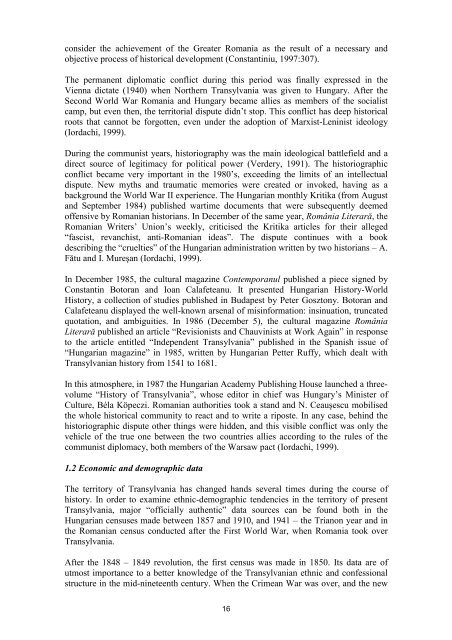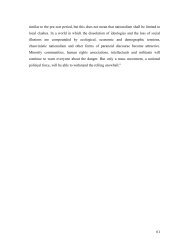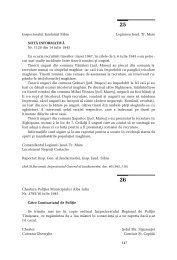Southeast Europe
Southeast Europe
Southeast Europe
You also want an ePaper? Increase the reach of your titles
YUMPU automatically turns print PDFs into web optimized ePapers that Google loves.
consider the achievement of the Greater Romania as the result of a necessary and<br />
objective process of historical development (Constantiniu, 1997:307).<br />
The permanent diplomatic conflict during this period was finally expressed in the<br />
Vienna dictate (1940) when Northern Transylvania was given to Hungary. After the<br />
Second World War Romania and Hungary became allies as members of the socialist<br />
camp, but even then, the territorial dispute didn’t stop. This conflict has deep historical<br />
roots that cannot be forgotten, even under the adoption of Marxist-Leninist ideology<br />
(Iordachi, 1999).<br />
During the communist years, historiography was the main ideological battlefield and a<br />
direct source of legitimacy for political power (Verdery, 1991). The historiographic<br />
conflict became very important in the 1980’s, exceeding the limits of an intellectual<br />
dispute. New myths and traumatic memories were created or invoked, having as a<br />
background the World War II experience. The Hungarian monthly Kritika (from August<br />
and September 1984) published wartime documents that were subsequently deemed<br />
offensive by Romanian historians. In December of the same year, România Literară, the<br />
Romanian Writers’ Union’s weekly, criticised the Kritika articles for their alleged<br />
“fascist, revanchist, anti-Romanian ideas”. The dispute continues with a book<br />
describing the “cruelties” of the Hungarian administration written by two historians – A.<br />
Fătu and I. Mureşan (Iordachi, 1999).<br />
In December 1985, the cultural magazine Contemporanul published a piece signed by<br />
Constantin Botoran and Ioan Calafeteanu. It presented Hungarian History-World<br />
History, a collection of studies published in Budapest by Peter Gosztony. Botoran and<br />
Calafeteanu displayed the well-known arsenal of misinformation: insinuation, truncated<br />
quotation, and ambiguities. In 1986 (December 5), the cultural magazine România<br />
Literară published an article “Revisionists and Chauvinists at Work Again” in response<br />
to the article entitled “Independent Transylvania” published in the Spanish issue of<br />
“Hungarian magazine” in 1985, written by Hungarian Petter Ruffy, which dealt with<br />
Transylvanian history from 1541 to 1681.<br />
In this atmosphere, in 1987 the Hungarian Academy Publishing House launched a threevolume<br />
“History of Transylvania”, whose editor in chief was Hungary’s Minister of<br />
Culture, Béla Köpeczi. Romanian authorities took a stand and N. Ceauşescu mobilised<br />
the whole historical community to react and to write a riposte. In any case, behind the<br />
historiographic dispute other things were hidden, and this visible conflict was only the<br />
vehicle of the true one between the two countries allies according to the rules of the<br />
communist diplomacy, both members of the Warsaw pact (Iordachi, 1999).<br />
1.2 Economic and demographic data<br />
The territory of Transylvania has changed hands several times during the course of<br />
history. In order to examine ethnic-demographic tendencies in the territory of present<br />
Transylvania, major “officially authentic” data sources can be found both in the<br />
Hungarian censuses made between 1857 and 1910, and 1941 – the Trianon year and in<br />
the Romanian census conducted after the First World War, when Romania took over<br />
Transylvania.<br />
After the 1848 – 1849 revolution, the first census was made in 1850. Its data are of<br />
utmost importance to a better knowledge of the Transylvanian ethnic and confessional<br />
structure in the mid-nineteenth century. When the Crimean War was over, and the new<br />
16









